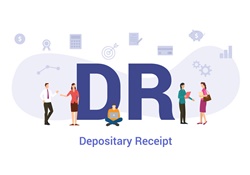
Table of Contents
What is Depositary Receipt?
Investment is crucial as the same decides the lifestyle of a man. For a mindful investment, there are many options in the Market. Among others, has the thought of Investing in stocks of any foreign companies crossed your mind?

If yes, you must have wandered around many options, including Depositary Receipts (DRs). The definition of DR states that it is a financial tool that enables investors to invest in equity of a company based overseas.
Traditionally, investment in foreign company equity was possible via a Demat account and a Bank account with prescribed funds in the country you seek to invest. As per the Reserve Bank of India (RBI), equity investment amounting to $200,000 is permissible. Depositary receipts are such financial instruments wherein the investor can seek long-term rewards with no hassle. The mechanism of the same is like any equity share with a small difference.
The Indian stock market trades within the Range of its borders, meaning with the stocks of Indian listed companies. These companies can be registered overseas, but should carry out a significant business in India to make their shares available for Indians. If you are looking to invest in stocks of international companies like Google, Microsoft, or Apple, Indian depositary Receipts will come into the picture.
What is an Indian depositary receipt?
For domestic depositaries, it is essential to create Indian Depositary Receipt (IDR) in the Indian currency. In India, domestic depositories are Securities and Exchange Board of India (SEBI) registered custodians. An IDR is issued against the Underlying equity of a company to allow an overseas company to raise funds via Indian securities markets. As per the regulation, IDRs are the only option available for the foreign company willing to list in the equity market.
With the help of depositary receipts, direct investment in international companies is possible. The foreign companies interested in getting listed in the Indian stock market have subsidiaries in India. However, despite these subsidiaries, the companies do not qualify to get through the listing. Thus, IDRs help these foreign companies to reach the Indian investor. The first company to issue an IDR was Standard Chartered Plc.
The Indian depositary receipts falls under American Depositary Receipts, which were introduced in 1927. RBI issues operations of IDRs under the Foreign Exchange Management Act. In 2020, the first-ever Indian depositary receipts floated across Bombay Stock Exchange (BSE) and National Stock Exchange (NSE).
Talk to our investment specialist
Depositary Receipts Types
As discussed above, depositary receipts have co-existed with other financial instruments across the globe for a long time. Needless to say, because of its age-old existence, the depositary receipts evolved. Presently, there are three types of depositary receipts, namely, American depositary receipts, European depositary receipts, and Global depositary receipts.
1. American Depositary Receipts
People living in America can utilize American depositary receipts on all three major U.S. exchanges and OTC markets. These are further divided into sponsored and non-sponsored depositary receipts. IDRs fall under this category.
Sponsored depositary receipts
These receipts are further divided into three different levels. Level one is the most popular and requires menial reporting from the companies’ end, and is available at OTC markets. Level two requires companies to meet the Securities and Exchange Commission (SEC) for disclosure requirements. After qualifying, the company gets listed in the major exchanges. Level three requires stringent regulation qualification to get permission for issuing shares and DRs in all three exchanges.
Non-sponsored depositary receipts
Here, companies get listed with OTC markets without having an agreement with a depositary bank.
2. European Depositary Receipts
These are exactly the opposite of American depositary receipts. These are the shares of American companies that are seeking permission for accessing foreign markets such as the London Stock Exchange. The foreign company signs a depositary receipts agreement with a London bank. These banks sell the respective companies' shares on London Stock Exchange.
3. Global Depositary Receipts
The term global defines the bandwidth of the depositary receipts. These are similar to the concepts of ADRs and EDRs but in a broader sense. Any company can release shares to numerous countries. The same isn’t restricted to one country.
Depositary Receipts vs Common Stock
Depositary receipts represent the shares of an overseas company. This concept is different from the common stock of a company. Once depositary receipts get listed, and trading begins, the same is treated as any regular shares of a company. On the other hand, common stocks are corporate equity ownerships. In some cases, the Initial Public Offerings (IPOs) of a company might convert DRs into common stock. Ideally, DRs and common stocks are kept separate.
Conclusion
DRs are reliable investment tools that have benefitted generations. The changing scenario of the world is pushing towards expansions and thus pushing the boundaries for DRs. The future is anticipated to hold surprises for investors in depositary receipts.
All efforts have been made to ensure the information provided here is accurate. However, no guarantees are made regarding correctness of data. Please verify with scheme information document before making any investment.






